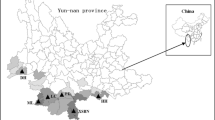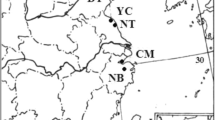Abstract
Satureja bachtiarica Bunge (Lamiaceae) is a medicinal plant native to Iran which is widely used in traditional medicine, as a spice and as a vegetable. Understanding the patterns of genetic variation and structure of natural populations of the plant will be crucial for breeding and management purposes. However, until now, there has been no molecular tool with codominance inheritance available for studying genetic variation in this plant. In this study, we developed microsatellite markers for S. bachtiarica using a next-generation sequencing technique, and applied these markers to quantify the genetic variation and structure of natural populations. Sixty individuals collected from five natural populations were tested with 15 markers, 11 of which were fund to be polymorphic. The number of alleles per locus ranged from 4 to 17, with an average of 7.5 alleles per locus. The polymorphic information content of loci ranged from 0.41 to 0.89, with an average of 0.63. The average observed and expected heterozygosities over all populations were 0.62 (range 0.58 to 0.69) and 0.61 (range 0.60 to 0.63), respectively, and a low level of inbreeding (FIS) was observed in all populations (ranging from − 0.08 to 0.10) except Boli. None of the populations revealed any signature of recent reduction in population size. Private allelic richness was positively correlated with elevation (P < 0.05). The mean pairwise FST (± SD) among populations was 0.07 ± 0.01 (range 0.05 to 0.10). The clustering and Bayesian structure analyses exhibited genetic admixture between populations as supported by a weak population differentiation. The results of this study show the high efficiency of developed markers to investigate the genetics of natural populations of S. bachtiarica. The developed markers can also help to screen natural variation in diverse populations of closely related species, and can consequently be applied in conservation genetic and breeding programs.



Similar content being viewed by others
References
Ceballos G, Davidson A, List R, Pacheco J, Manzano-Fischer P, Santos-Barrera G, Cruzado J (2010) Rapid decline of a grassland system and its ecological and conservation implications. PLoS One 5:e8562
Chizzola R (2001) Volatile oil composition of four populations of Satureja montana L. from southern France. In: International symposium on sustainable use of plant biodiversity to promote new opportunities for horticultural production 598, pp 143–147
Dodoš T, Rajčević N, Tešević V, Matevski V, Janaćković P, Marin PD (2015) Composition of leaf n-alkanes in three Satureja montana L. subspecies from the Balkan peninsula: ecological and taxonomic aspects. Chem Biodivers 12:157–169
Doyle JJ (1987) A rapid DNA isolation procedure for small quantities of fresh leaf tissue. Phytochem Bull 19:11–15
Earl DA (2012) STRUCTURE HARVESTER: a website and program for visualizing STRUCTURE output and implementing the Evanno method. Conserv Genet Resour 4:359–361
Evanno G, Regnaut S, Goudet J (2005) Detecting the number of clusters of individuals using the software STRUCTURE: a simulation study. Mol Ecol 14:2611–2620
Falahati Anbaran M, Stenøien HK, Bolstad GH, Hansen TF, Pérez Barrales R, Armbruster WS, Pélabon C (2017) Novel microsatellite markers for Dalechampia scandens (E uphorbiaceae) and closely related taxa: application to studying a species complex. Plant Species Biol 32:179–186
Figueiredo AC, Barroso JG, Pedro LG, Scheffer JJ (2008) Factors affecting secondary metabolite production in plants: volatile components and essential oils. Flavour Fragr J 23:213–226
Ghaffarzadeh-Namazi L, Babaeian N, Ghamari-Zare A, Nematzadeh G (2015) Cryopreservation the seeds of the medicinal plant Satureja bachtiarica. Bunge. Int J Biosci (IJB) 6:24–29
Gilpin ME, Soule ME (1986) Minimum viable populations: processes of species extinction. In Soule ME, Conservation biology: the science of scarcity and diversity. Sinauer, Sunderland, MA, 19–34
Gonçalves-Vidigal MC, Rubiano LB (2011) Development and application of microsatellites in plant breeding. Crop Breed Appl Biotechnol 11:66–72
Güllüce M, Sökmen M, Daferera D, Aǧar G, Özkan H, Kartal N, Polissiou M, Sökmen A, Sahin F (2003) In vitro antibacterial, antifungal, and antioxidant activities of the essential oil and methanol extracts of herbal parts and callus cultures of Satureja hortensis. L. J Agric Food Chem 51:3958–3965
Hadian J, Khadivi‐Khub A (2014) Relationships among fourteen species of Satureja growing wild in Iran detected with molecular markers. Plant Biol 16:1020-1024
Hadian J, Raeisi S, Azizi A, Pezhmanmehr M, Sarkhosh A (2017) Genetic diversity of natural populations of medicinally valuable plant Satureja khuzistanica Jamzad based on ISSR markers. Braz J Bot 4: 771-781
Jafari F, Ghavidel F, Zarshenas MM (2016) A critical overview on the pharmacological and clinical aspects of popular Satureja species. J Acupunct Meridian Stud 9:118–127
Kalinowski ST (2005) HP-RARE 1.0: a computer program for performing rarefaction on measures of allelic richness. Mol Ecol Notes 5:187–189
Kalinowski ST, Taper ML, Marshall TC (2007) Revising how the computer program CERVUS accommodates genotyping error increases success in paternity assignment. Mol Ecol 16:1099–1106
Keyhani J, Paknia E, Keyhani E, Ghaffari S (2007) Identification of peroxidase isoenzymes in Satureja hortensis L. leaves. In: I international medicinal and aromatic plants conference on culinary herbs 826. pp 337–344
Khadivi-Khub A, Salehi-Arjmand H, Movahedi K, Hadian J (2015) Molecular and morphological variability of Satureja bachtiarica in Iran. Plant Syst Evol 301:77–93
Kopelman NM, Mayzel J, Jakobsson M, Rosenberg NA, Mayrose I (2015) Clumpak: a program for identifying clustering modes and packaging population structure inferences across.. Mol Ecol Resour 15:1179–1191
Langella O (1999) Populations, 1.2. 28 http://www.cnrs-gif.fr/pge. Accessed 15 June 2017
Levinson G, Gutman GA (1987) Slipped-strand mispairing: a major mechanism for DNA sequence evolution. Mol Biol Evol 4:203–221
Leys M, Keller I, Räsänen K, Gattolliat J-L, Robinson CT (2016) Distribution and population genetic variation of cryptic species of the Alpine mayfly Baetis alpinus (Ephemeroptera: Baetidae) in the Central Alps. BMC Evol Biol 16:77
Malausa T et al (2011) High throughput microsatellite isolation through 454 GS-FLX Titanium pyrosequencing of enriched DNA libraries. Mol Ecol Resour 11:638–644
Meglécz E, Costedoat C, Dubut V, Gilles A, Malausa T, Pech N, Martin J-F (2010) QDD: a user-friendly program to select microsatellite markers and design primers from large sequencing projects. Bioinformatics 26:403–404
Moein M, Karami F, Tavallali H, Ghasemi Y (2012) Chemical composition of the essential oil of Satureja bachtiarica Bunge. from Iran. Iran J Pharm Sci 8:277–281
Mohebi J, Jamzad Z, Bakhshi-Khaniki G (2016) The conservation status of six endemic Satureja species in Iran. J Iran Nat 1:74–79
Momtaz S, Abdollahi M (2008) A systematic review of the biological activities of Satureja L. species. Pharmacol Online 2:34–54
Nasab FK, Khosravi AR (2014) Ethnobotanical study of medicinal plants of Sirjan in Kerman Province, Iran. J Ethnopharmacol 154:190–197
Nei M, Tajima F, Tateno Y (1983) Accuracy of estimated phylogenetic trees from molecular data. J Mol Evol 19:153–170
Peakall R, Smouse PE (2006) GENALEX 6: genetic analysis in Excel. Population genetic software for teaching and research. Mol Ecol Notes 6:288–295
Pfefferkorn A, Krüger H, Pank F (2008) Chemical composition of Satureja hortensis L essential oils depending on ontogenetic stage and season. J Essent Oil Res 20:303–305
Piry S, Luikart G, Cornuet J-M (1999) Computer note. BOTTLENECK: a computer program for detecting recent reductions in the effective size using allele frequency data. J Hered 90:502–503
Potts SG, Dafni A, Ne'eman G (2001) Pollination of a core flowering shrub species in Mediterranean phrygana: variation in pollinator diversity, abundance and effectiveness in response to fire. Oikos 92:71–80
Pritchard JK, Stephens M, Donnelly P (2000) Inference of population structure using multilocus genotype data. Genetics 155:945–959
Rechinger K (1982) Satureja. Flora Iranica: Desiranischen Hoclandes and der Umrahmenden Gebirge vol. 150. Akademische Druku Verlags Antalt Graz, Austria, pp. 495-504.
Rijal DP, Falahati-Anbaran M, Alm T, Alsos IG (2015) Microsatellite markers for Heracleum persicum (Apiaceae) and allied taxa: application of next-generation sequencing to develop genetic resources for invasive species management. Plant Mol Biol Report 33:1381–1390
Rostami R, Khoshbakht K (2012) Conservation status and sustainable local use of crop and crop wild relative species in the Bistoon protected area/West of Iran. J Agrobiol 29:55–62
Rousset F (2008) GENEPOP’007: a complete re-implementation of the GENEPOP software for Windows and Linux. Mol Ecol Resour 8:103–106. https://doi.org/10.1111/j.1471-8286.2007.01931.x
Saeidnia S, Gohari AR, Manayi A, Kourepaz-Mahmoodabadi M (2015) Satureja: ethnomedicine, phytochemical diversity and pharmacological activities. Springer. Cham, Switzerland, 2016; pp. 1–2.
Saidi M, Movahedi K, Mehrabi AA (2013a) Characterization of genetic diversity in Satureja bachtiarica germplasm in Ilam proviance (Iran) using ISSR and RAPD markers. Intl J Agri Crop Sci 5:1934
Saidi M, Movahedi K, Mehrabi AA, Kahrizi D (2013b) Molecular genetic diversity of Satureja bachtiarica. Mol Biol Rep 40:6501–6508
Salehi-Arjmand H, Hadian J, Khadivi-Khub A, Akramian M (2014) Comparative analysis of essential oil compositions in seven populations of Bakhtiarian savory in natural and field conditions. Acta Physiol Plant 36:1107–1114
Sefidkon F, Jamzad Z (2005) Chemical composition of the essential oil of three Iranian Satureja species (S. mutica, S. macrantha and S. intermedia). Food Chem 91:1–4
Stift G, Pachner M, Lelley T (2003) Comparison of RAPD fragment separation in agarose and polyacrylamide gel by studying Cucurbita species. Rep Cucurbit Genet Coop. 26:62–65
Tepe B, Cilkiz M (2016) A pharmacological and phytochemical overview on Satureja. Pharm Biol 54:375–412
Tsoktouridis G, Maloupa E, Krigas N (2009) Phylogenetic analysis of six closely related Mediterranean taxa of Lamiaceae, using the ITS1, 5.8 S and ITS2 nuclear ribosomal regions. Acta Hortic:307–315
Turchetto C, Segatto ALA, Beduschi J, Bonatto SL, Freitas LB (2015) Genetic differentiation and hybrid identification using microsatellite markers in closely related wild species. AoB Plants 7
Zhivotovsky LA (2015) Relationships between Wright’s F ST and F IS statistics in a context of Wahlund effect. J Hered 106:306–309
Acknowledgments
Authors thank Dr. Sverre Lundemo for his valuable comments and efforts to improve the language of the final version of the manuscript.
Funding
This research is supported by a grant no. PHD95100659 from the Iran National Science Foundation (INSF).
Author information
Authors and Affiliations
Corresponding author
Additional information
Publisher’s Note
Springer Nature remains neutral with regard to jurisdictional claims in published maps and institutional affiliations.
Electronic Supplementary Material
ESM 1
(DOC 110 kb)
Rights and permissions
About this article
Cite this article
Movahedi, R., Shojaeiyan, A., Falahati-Anbaran, M. et al. Genetic Variation and Structure in Natural Populations of a Medicinal Vegetable, Satureja bachtiarica, Inferred from Microsatellite Markers Developed Using Next-Generation Sequencing. Plant Mol Biol Rep 37, 14–23 (2019). https://doi.org/10.1007/s11105-018-1126-7
Published:
Issue Date:
DOI: https://doi.org/10.1007/s11105-018-1126-7




